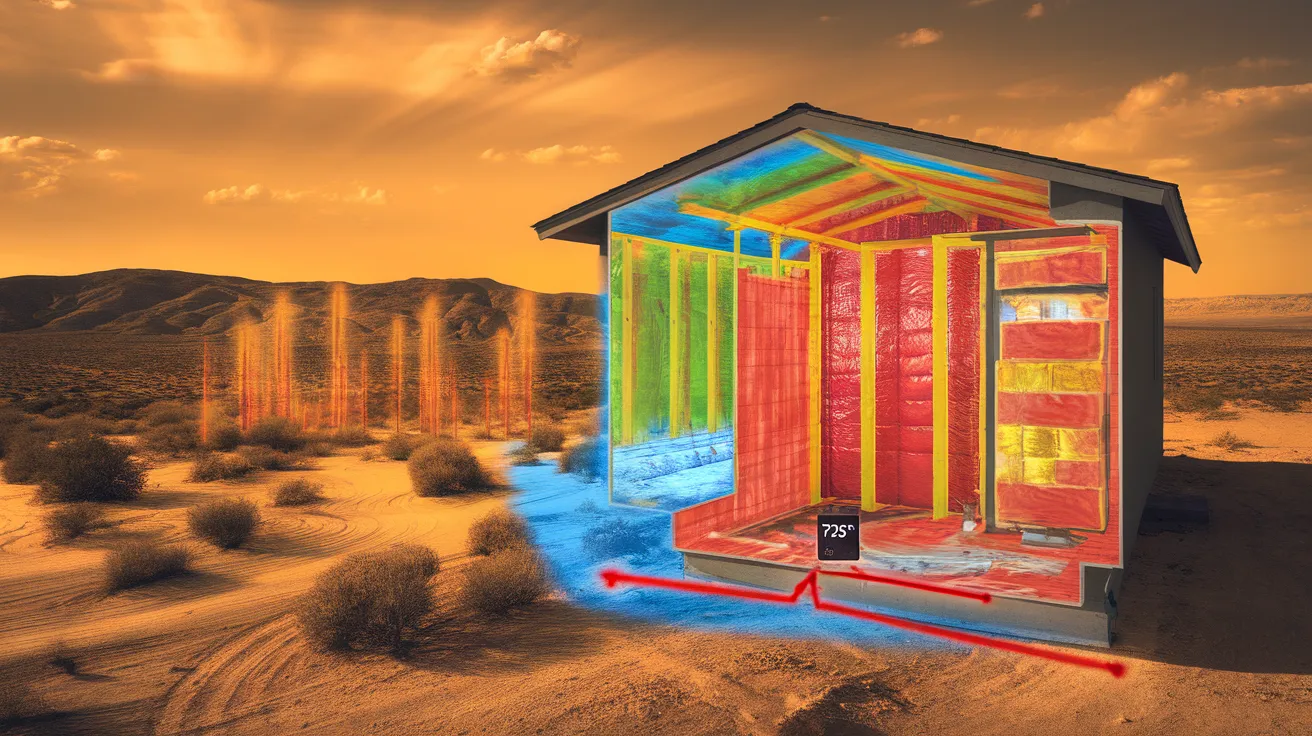Maintaining comfort in the scorching Southern Utah weather can be budget-friendly while saving energy. Focus on proper insulation, smart thermostat settings, and scheduled AC servicing. Utilize natural ventilation, shade your windows, and look into the perks of high-efficiency ductless units. Don't overlook the impact of strategic landscaping, such as carefully positioned trees and reflective paving materials, which can decrease thermal gain. Interested in learning the specifics of turning your home into a summer oasis without maxing out your AC and inflating your utility bills? Follow along!

Key Findings
Exploring the Basics of Energy-Efficient Air Conditioning
You may assume that turning up the air conditioner is the only way to maintain a cool house during summer, knowing the basics of energy-efficient cooling can change your perspective. It's not just about comfort, it's also about energy conservation. Remember that cooling techniques like shading, ventilation, and insulation can significantly decrease your energy usage. By adding proper insulation, you're blocking cool air from escaping, thereby reducing the need to continuously run your AC. Using window covers, especially those exposed to sunlight, can minimize heat buildup. And ventilation, whether natural or mechanical, helps circulate air, keeping your home cool. A more energy-efficient home isn't just economical, it's better for the environment too.
Picking the Best Air Conditioner
Having knowledge of energy-saving cooling techniques is a solid basis. However, choosing the right air conditioning system is key to get the most from these techniques. Deciding between central and ductless is a significant decision. Central air provides whole-house cooling, while ductless systems target individual zones. Both options have their benefits, but ductless units often save more energy if some areas are used less frequently. Look at energy efficiency numbers when making your choice. Better ratings mean more energy savings, but may cost more initially. It's about finding the right balance, but investing in high-efficiency equipment can reduce costs over time. Note that proper equipment helps control that Southern Utah heat efficiently.
The Importance of Home Insulation in Regulating Home Temperature
Although it may not be the first thing you think about, proper insulation serves an essential role in regulating indoor comfort during the warmest times of the year. Insulation materials work by providing thermal resistance, decreasing the rate of heat transfer from your living areas to the hot exterior. This shows that the conditioned air produced by your air conditioning system is retained more effectively, reducing the strain on your AC unit and saving you money on energy bills. It's important to choose insulation with a high R-value, which signifies greater thermal resistance. From spray foam to fiberglass, the right insulation can make a world of difference in your home's warm-weather comfort and energy performance.
Maximizing the Power of Natural Ventilation
You can leverage natural ventilation to help keep your home comfortable and reduce your energy expenses. By learning about how it works, you can maximize the advantages of cross-ventilation during the day. Moreover, adopting a nighttime ventilation approach can provide significant cooling benefits when temperatures fall.
Exploring Natural Ventilation
While it may seem complicated, understanding natural ventilation is actually quite simple. It's essentially about optimizing the airflow in your home to ensure a pleasant environment while decreasing reliance on power-consuming air conditioning. The key is understanding when to open your windows and doors to allow fresh air to enter, and when to shut them to keep the heat out. You'll need to learn about different ventilation methods that can optimize airflow, such as placing fans effectively and creating pathways for air to circulate. By utilizing the power of natural ventilation, you're not only reducing indoor temperatures, you're also contributing to a more sustainable future.
Understanding Cross-Ventilation Benefits
To maximize the potential of the power of natural ventilation, it's crucial to enhance cross-ventilation benefits. This involves strategic window placement and utilizing cross ventilation strategies. When fitting windows, aim for those that are placed on opposing walls. This forms a flow path for air to move easily throughout your home, creating natural cooling.
Furthermore, you can enhance this airflow by keeping open adjacent windows. This encourages a cross breeze that can considerably reduce indoor temperatures. To make the most of the effectiveness, make sure that the windows are not blocked by obstacles, both inside and outside, such as household items or vegetation. By focusing on these factors, you're optimizing natural ventilation and lowering your need on energy-consuming cooling systems.
Nighttime Ventilation Strategy
Although hot summer days may be blazing hot, the nights typically deliver a refreshing coolness that you can utilize to your benefit. This is when an evening cooling strategy becomes valuable. By leveraging the benefits of natural airflow, you can create efficient evening temperature control and improved air circulation.
Begin by unlocking windows and doors when the outside temperature drops below the inside temperature. This promotes cool air to come inside and drive the warm air out, creating a natural air circulation. Then, as daybreak comes and the temperature begins to rise, shut everything up to retain the cool air inside. Applying this simple yet effective strategy can bring about a substantial difference in keeping a cozy and energy-saving home during the sweltering Southern Utah summers.
The Critical Role of AC Maintenance
You might not realize it, but regular HVAC upkeep is crucial in stopping system failures during the hottest times of the year. Not only does it boost your AC's functionality, but it's also vital for prolonging the unit's service life. Here's why why this is essential to your home's energy efficiency.
Managing Network Overloading
When summer temperatures can push your AC system to its limits, consistent servicing can help stop system overloads. Think of your AC as a car. Would you begin a lengthy journey without inspecting the oil, right? The same goes for your cooling system. Regular check-ups can ensure efficient operation, minimize the chance of failures, and help with energy savings.
Important maintenance tasks include monthly filter replacement, cleaning the coils, and verifying sufficient refrigerant. Overlooking these essential procedures can lead to inefficiencies, forcing your cooling system to operate inefficiently and use more electricity. So, give your AC the attention it needs. Regular maintenance not merely minimizes system overloads but further lengthens its operational duration.
Maximizing AC Performance
To make sure your AC runs at optimal levels, scheduled servicing must be a top priority. Failing to do this can lead to decreasing efficiency and increasing bills. Don't let that happen. AC performance guidelines include periodically replacing or cleaning filters, verifying your system operates efficiently.
Upgrading your cooling system can make a significant difference. Installing a programmable thermostat enables you to adjust temperature settings, saving energy while you're away. Another important step is addressing duct leakage. Unsealed ducts may lose as much as 30% of your AC's efficiency.
To get the best performance from your AC, you'll need to keep up with upkeep and look into system enhancement options. The result will be better indoor comfort and more manageable utility expenses this summer.
Prolonging Equipment Durability
In addition to the direct benefits of lower power usage and financial advantages, consistent AC maintenance is essential in prolonging the longevity of your unit. Proper equipment maintenance extends further than resolving issues as they emerge; it's about stopping them before they happen. By routinely cleaning and inspecting your AC system, you minimize system strain, enhance operation, and prolong its service life. Consider it an investment in longevity. Remember, a regularly maintained AC unit doesn't just perform better it has extended durability. So, don't neglect regular maintenance. It'll ensure optimal system performance, save you money in the long run, and help you handle the Southern Utah heat effectively and efficiently.
Intelligent Thermostats: The Future of Energy Conservation
If you're searching for a practical approach to energy conservation this summer, a smart thermostat could be the innovation you need. Being able to memorize your daily habits and modify temperatures automatically, it surpasses conventional thermostats. The benefits of a smart thermostat extend past simple convenience. Through implementing one, you're making an informed decision to optimize energy usage in your home, and this produces significant energy savings. You can also manage from anywhere it through an app, delivering even more flexibility. In essence, a smart thermostat gives you complete command of your home's energy use, keeping you comfortable in the Southern Utah heat without breaking the bank.
Smart Landscaping Strategies for Enhanced Cooling and Energy Savings
Although a smart thermostat is an effective way of controlling energy use in your home, another effective method lies in smart landscaping. Installing shade trees on the south and west sides of your home will lower your air conditioning needs significantly. These leafy giants function as natural barriers against the sun's heat, supporting outdoor cooling.
Think about incorporating xeriscaping plants within your landscape. These low-water varieties demand minimal water, helping save this important resource. Moreover, their natural capacity to survive in hot conditions promotes a more temperate atmosphere.
Lastly, steer clear of highly absorbent materials for patios or walkways. Select reflective surfaces instead. These surfaces reflect the sun's rays, additionally lowering heat around your home and improving your energy efficiency.
Common Questions
How Does Humidity Impact Energy-Efficient Cooling Throughout Southern Utah's Climate?
Moisture levels influence how efficiently your cooling website system operates. Your system uses more energy when dealing with humid air, which means more power is needed. Therefore, installing a dehumidifier can help reduce your AC's workload and reduce your energy costs.
What Are Some Energy-Efficient Alternatives to Air Conditioning?
Consider evaporative coolers and ceiling fans as energy-efficient alternatives to air conditioning. They're effective, are energy-conscious, and reduce your energy footprint. It's a practical, economical option for keeping your Southern Utah home cool.
How Effective Is Solar Power for Cooling Applications
Yes, you are able to use solar power for eco-friendly cooling. Solar cooling systems utilize solar panel efficiency to energize your cooling demands, making it a green, cost-effective solution to traditional air conditioning.
How Does Nighttime Temperature Affect Energy Efficiency?
When nighttime temperatures fall, you have a chance to enhance power consumption. Open your windows to welcome the cool air, helping decrease reliance on air conditioning. Keep in mind that strategically controlling overnight temperature drops efficiently addresses varying temperatures.
Tax Benefits Available When Installing Energy-Efficient Cooling Systems
You're eligible for tax incentives when putting in eco-friendly cooling solutions. Check out federal and local programs for installation rebates. That's a smart approach to offset costs while minimizing your environmental impact and summer cooling bills.
Final Thoughts
You're ready to beat the Southern Utah heat this summer! Keep in mind, an energy-efficient cooling system isn't as elusive as finding a snowball in the desert. With the right AC, quality insulation, proper ventilation, regular maintenance, a smart thermostat, and strategic landscaping, you can create a pleasant, relaxing home without breaking the bank. You're conserving energy and, you're also taking a significant step towards eco-friendly living.
 Haley Joel Osment Then & Now!
Haley Joel Osment Then & Now! Spencer Elden Then & Now!
Spencer Elden Then & Now! Amanda Bynes Then & Now!
Amanda Bynes Then & Now! Pauley Perrette Then & Now!
Pauley Perrette Then & Now! Teri Hatcher Then & Now!
Teri Hatcher Then & Now!